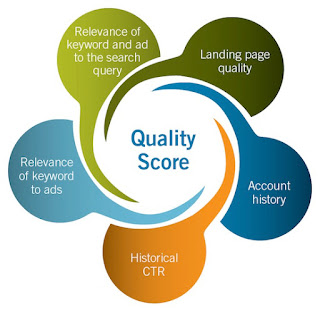What Is Quality Score & How Does it Affect PPC?
If you’re trying to master PPC, you need a solid knowledge of Quality Score. That’s because
your Quality Scores have excessive influence over the cost and capability of your paid
search campaigns.Only your credit can disturb rather not you certify for a loan Google
Quality Score affects how your PPC ads is working and how much you need to pay for
each click.Know more about Quality Score at PPC Training in Chandigarh.
your Quality Scores have excessive influence over the cost and capability of your paid
search campaigns.Only your credit can disturb rather not you certify for a loan Google
Quality Score affects how your PPC ads is working and how much you need to pay for
each click.Know more about Quality Score at PPC Training in Chandigarh.
What is Quality Score?
Quality Score is Google's rating of the quality and importance of both your keywords and
PPC ads. It is used to resolve your cost per click (CPC) and aggregated by your maximum
price to determine your ad rank in the ad action process. Your Quality Score build on
multiple factors, including:
PPC ads. It is used to resolve your cost per click (CPC) and aggregated by your maximum
price to determine your ad rank in the ad action process. Your Quality Score build on
multiple factors, including:
- Click-through rate (CTR).
- The applicability of each keyword to its ad group.
- Landing page quality and importance.
- The availability of your ad text.
- Your actual AdWords account performance.
Outside Google appreciate complete how much each factor works for the Quality
Score algorithm. When more people who see your ad click on it that an secure account
to Google and your ads are relevant and helpful to users. Google benefits :
Score algorithm. When more people who see your ad click on it that an secure account
to Google and your ads are relevant and helpful to users. Google benefits :
- Higher ad ranking
- Lower costs
Benefits of Improving Google Quality Score
By evaluate thousands of PPC accounts, we know that Quality Score has a direct
parallel on your PPC success. By enhance your Quality Scores, you’ll be setting
yourself up for bigger return on investment (ROI). The Quality Scores interact with
lower cost per alteration Cost per growth is different from cost per click.
parallel on your PPC success. By enhance your Quality Scores, you’ll be setting
yourself up for bigger return on investment (ROI). The Quality Scores interact with
lower cost per alteration Cost per growth is different from cost per click.
Generally speaking, the higher your Quality Score, the lower your cost per conversion.
Remember, a high Quality Score is Google's way of asking that your PPC ad meets your
potential customers’ needs. The better you are at meeting the prospect’s needs, the less
Google will charge you for the ad click.
Inmprove your Quality Score by PPC Training in Chandigarh.
Remember, a high Quality Score is Google's way of asking that your PPC ad meets your
potential customers’ needs. The better you are at meeting the prospect’s needs, the less
Google will charge you for the ad click.
Inmprove your Quality Score by PPC Training in Chandigarh.
How Do You Increase Your Quality Score?
It is important to boost your ratings by working daily on your account. This can be conclude
by appeal your efforts on many key places:
by appeal your efforts on many key places:
Keyword Research – Discover new, highly suitable keywords to add to your campaigns,
including long tail freedom that can grant to the bulk of your overall traffic.
Keyword Organization – Split your keywords into compact, classified groups that can be
more definitely tied to individual ad campaigns.
Refining Ad Text – Test out PPC ad copy that is more focused to your original ad groups.
More effective ads get above CTR, one of the best ways to advance Quality Score.
Optimizing Landing Pages – Follow landing page best method to create pages that connect
straight with your ad groups and provide a united background for visitors, from keyword to growth.
Adding Negative Keywords – Regularly research, identify, and boycott irrelevant search
terms that are consume your budget.
As you can see, Quality Score is mainly a measure of applicability, and improving keyword
Quality Score is a matter of grouping your PPC offencive into small, well organized, strongly
knit groups of keywords. Better keyword research and company will automatically correct
the quality and particularly of your ads and website content, allowing you to destination the
exact gathering most likely to be findingfor your offerings.
Quality Score is a matter of grouping your PPC offencive into small, well organized, strongly
knit groups of keywords. Better keyword research and company will automatically correct
the quality and particularly of your ads and website content, allowing you to destination the
exact gathering most likely to be findingfor your offerings.
Low AdWords Quality Scores are basically the result of separate between keywords, ad
groups, ad text, and landing page content. A high Quality Score comes naturally when an
AdWords account contains formed keywords in relevant keyword groups, ad text that
conform with certain ad groups, and placing pages that connect with the ad text . While
there is no easy, reliable answer to developing your Quality Score formula, paying careful
debate to purpose will greatly improve your scores. Learn more about PPC
Campaign at PPC Training in Chandigarh.
groups, ad text, and landing page content. A high Quality Score comes naturally when an
AdWords account contains formed keywords in relevant keyword groups, ad text that
conform with certain ad groups, and placing pages that connect with the ad text . While
there is no easy, reliable answer to developing your Quality Score formula, paying careful
debate to purpose will greatly improve your scores. Learn more about PPC
Campaign at PPC Training in Chandigarh.



